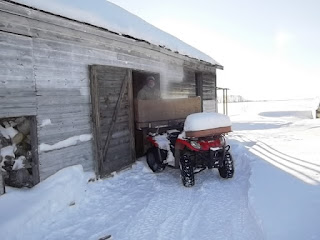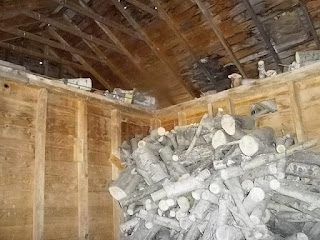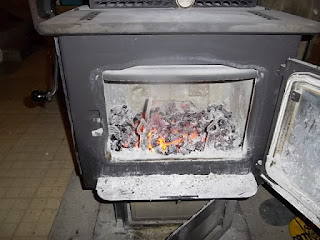It is minus 33 degrees Celsius. Combine that with the wind speed it is equivalent to minus 47 in my part of the world.
I remember it being about minus 50 degrees about 25 years ago. That was the time the rotor on the vehicle literally snapped off with a huge clang and a spurt as the motor came to a cold and grinding stop.
It is hard to image what people did in the past or why they even did it in order to survive in this part of the world of such extreme weather conditions.
What is it about this area that people have persevered with coping with the fact that if one left the shelter of their homes they would easily die just by the doing of it? No wild animal attack, no rebel militia hunting them down, no poisonous gases or steep cliffs or torrential rains to sweep them away. Just the simple turning of a door knob and the stepping away from the shelter for even less than 10 minutes could determine one's quick and surprisingly pain free demise.
Actually the pain would only begin when , and if , one returns to the warmth of the shelter. As toes and fingers begin to thaw there is a deep and burning itch which accompanies the deicing of human tissue . This discomfort can only be compared to that which occurs when one finds that the zipper on the one piece snow suit one has unwisely donned is 'caught'* and the beads of sweat start forming not only along your hairline but also starts to roll down the your spine as you struggle and twist and bite your tongue trying to get the *#(&# thing to pull down. Combine this with the inevitable consequence of the condensation caused call of Nature that occurs the moment one feels the indoor warmth and the panic filled realization that the socially acceptable conclusion is not probable within the next five minutes, makes the returning to the warmth of home and hearth almost as stressful and dangerous as the going out in the first place.
Things that I KNOW I have froze during my 60 years on the prairies are:
1. My ear. ..age 4...consequence of hat not being put on my head good 'nuff by my older sister.
2. My fingers....woolen mitts just do NOT do it for
-40 degrees.
3. My toes...consequence of curling on natural ice with just school shoes on during a day long high school bonspeil. There were tears that day as I placed my feet against the heater of the vehicle on the way home--which in hindsight was NOT a good idea.
4. My whole body almost got really cold when the little truck ran out of gas on a Saturday night in January. Good thing I was in town and not on our country road on the way home. (pre CB radios, pre cell phones).
Cold Weather First Aid
* The rule of the stuck zipper is that the amount of liquid consumed prior to the going out is directly proportional to the amount of material caught in the track.
I remember it being about minus 50 degrees about 25 years ago. That was the time the rotor on the vehicle literally snapped off with a huge clang and a spurt as the motor came to a cold and grinding stop.
It is hard to image what people did in the past or why they even did it in order to survive in this part of the world of such extreme weather conditions.
What is it about this area that people have persevered with coping with the fact that if one left the shelter of their homes they would easily die just by the doing of it? No wild animal attack, no rebel militia hunting them down, no poisonous gases or steep cliffs or torrential rains to sweep them away. Just the simple turning of a door knob and the stepping away from the shelter for even less than 10 minutes could determine one's quick and surprisingly pain free demise.
Actually the pain would only begin when , and if , one returns to the warmth of the shelter. As toes and fingers begin to thaw there is a deep and burning itch which accompanies the deicing of human tissue . This discomfort can only be compared to that which occurs when one finds that the zipper on the one piece snow suit one has unwisely donned is 'caught'* and the beads of sweat start forming not only along your hairline but also starts to roll down the your spine as you struggle and twist and bite your tongue trying to get the *#(&# thing to pull down. Combine this with the inevitable consequence of the condensation caused call of Nature that occurs the moment one feels the indoor warmth and the panic filled realization that the socially acceptable conclusion is not probable within the next five minutes, makes the returning to the warmth of home and hearth almost as stressful and dangerous as the going out in the first place.
Things that I KNOW I have froze during my 60 years on the prairies are:
1. My ear. ..age 4...consequence of hat not being put on my head good 'nuff by my older sister.
2. My fingers....woolen mitts just do NOT do it for
-40 degrees.
3. My toes...consequence of curling on natural ice with just school shoes on during a day long high school bonspeil. There were tears that day as I placed my feet against the heater of the vehicle on the way home--which in hindsight was NOT a good idea.
4. My whole body almost got really cold when the little truck ran out of gas on a Saturday night in January. Good thing I was in town and not on our country road on the way home. (pre CB radios, pre cell phones).
* The rule of the stuck zipper is that the amount of liquid consumed prior to the going out is directly proportional to the amount of material caught in the track.



















































